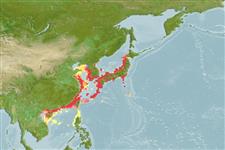>
Acropomatiformes (Oceanic basses) >
Lateolabracidae (Asian seaperches)
Etymology: Lateolabrax: Greek, latos, a fish of the Nile + Greek, labrax, -akos = a fish (Dicentrarchus labrax) (Ref. 45335).
More on author: Cuvier.
Issue
Junior synonym Lateolabrax maculatus considered as a valid species reported to be widely distributed (Japan, only in the Ariake Sea and off Nagasaki; China (off all coasts), Taiwan, and Korea (usually off the southern and western coasts) (Ref. 118669)
Environment: milieu / climate zone / depth range / distribution range
البيئة
بحري; المياه العذبة; مياه مخلوطة مرتبطة بالشعاب; أسماك نازلة (Ref. 51243); نطاق العمق 5 - ? m. Subtropical; 44°N - 15°N, 106°E - 143°E
Western Pacific: Japan to the South China Sea.
Length at first maturity / الحجم / وزن / العمر
Maturity: Lm ?, range 50 - ? cm
Max length : 102 cm TL ذكر/ مختلط الجنس; (Ref. 40637); common length : 16.1 cm SL ذكر/ مختلط الجنس; (Ref. 35840); أعلا وزن تم نشرة: 8.7 kg (Ref. 40637)
الأشواك الظهرية (المجموع) : 12 - 15; الأشعة الظهرية الناعمة (المجموع) : 12 - 14; شوكة شرجية: 3; أشعه شرجية لينه: 7 - 9.
Found in moving water of inshore rocky reefs. Juveniles may ascend rivers and return to sea to spawn. Protandrous, sex change happens after maturation at age 2 (Ref. 36558). Spawning occurs during winter, in deeper rocky reefs or inshore areas. Predaceous, feeding on zooplankton at an early age and on small fish and shrimps as adults (Ref. 12497). Utilized as a food fish (Ref. 559). Family placement uncertain (Ref. 1830). Used in Chinese medicine (Ref. 12166).
Males mature at age 2 years, becoming females when older (Ref. 36558). Juveniles may ascend rivers migrating to the sea to spawn (Ref. 36558).
Paxton, J.R., D.F. Hoese, G.R. Allen and J.E. Hanley, 1989. Pisces. Petromyzontidae to Carangidae. Zoological Catalogue of Australia, Vol. 7. Australian Government Publishing Service, Canberra, 665 p. (Ref. 7300)
IUCN Red List Status (Ref. 130435)
استخدامات بشرية
مصائد: تجاري; الأستزراع المائي: تجاري; لعبة سمكه: نعم
أدوات
تقارير خاصة
Download XML
مصادر علي الأنترنت
Estimates based on models
Preferred temperature (Ref.
123201): 12.7 - 26.3, mean 22.4 °C (based on 180 cells).
Phylogenetic diversity index (Ref.
82804): PD
50 = 1.0000 [Uniqueness, from 0.5 = low to 2.0 = high].
Bayesian length-weight: a=0.01259 (0.00885 - 0.01792), b=3.02 (2.92 - 3.12), in cm total length, based on LWR estimates for this species (Ref.
93245).
مستوى غذائي (Ref.
69278): 3.1 ±0.3 se; based on diet studies.
المرونه (Ref.
120179): وسيط, الحد الزمني الأدني لتضاعف عدد أفراد المجتمع 1.4-4.4 سنة (K=0.14-0.2; tm=2; Fec=1,726,242).
Fishing Vulnerability (Ref.
59153): Moderate to high vulnerability (52 of 100).
Climate Vulnerability (Ref.
125649): Moderate to high vulnerability (54 of 100).
Nutrients (Ref.
124155): Calcium = 16.5 [8.1, 32.0] mg/100g; Iron = 0.471 [0.277, 0.738] mg/100g; Protein = 20.1 [19.0, 21.0] %; Omega3 = 0.212 [0.131, 0.340] g/100g; Selenium = 24.4 [12.4, 44.2] μg/100g; VitaminA = 24.7 [8.1, 76.3] μg/100g; Zinc = 0.756 [0.525, 1.096] mg/100g (wet weight); based on
nutrient studies.
